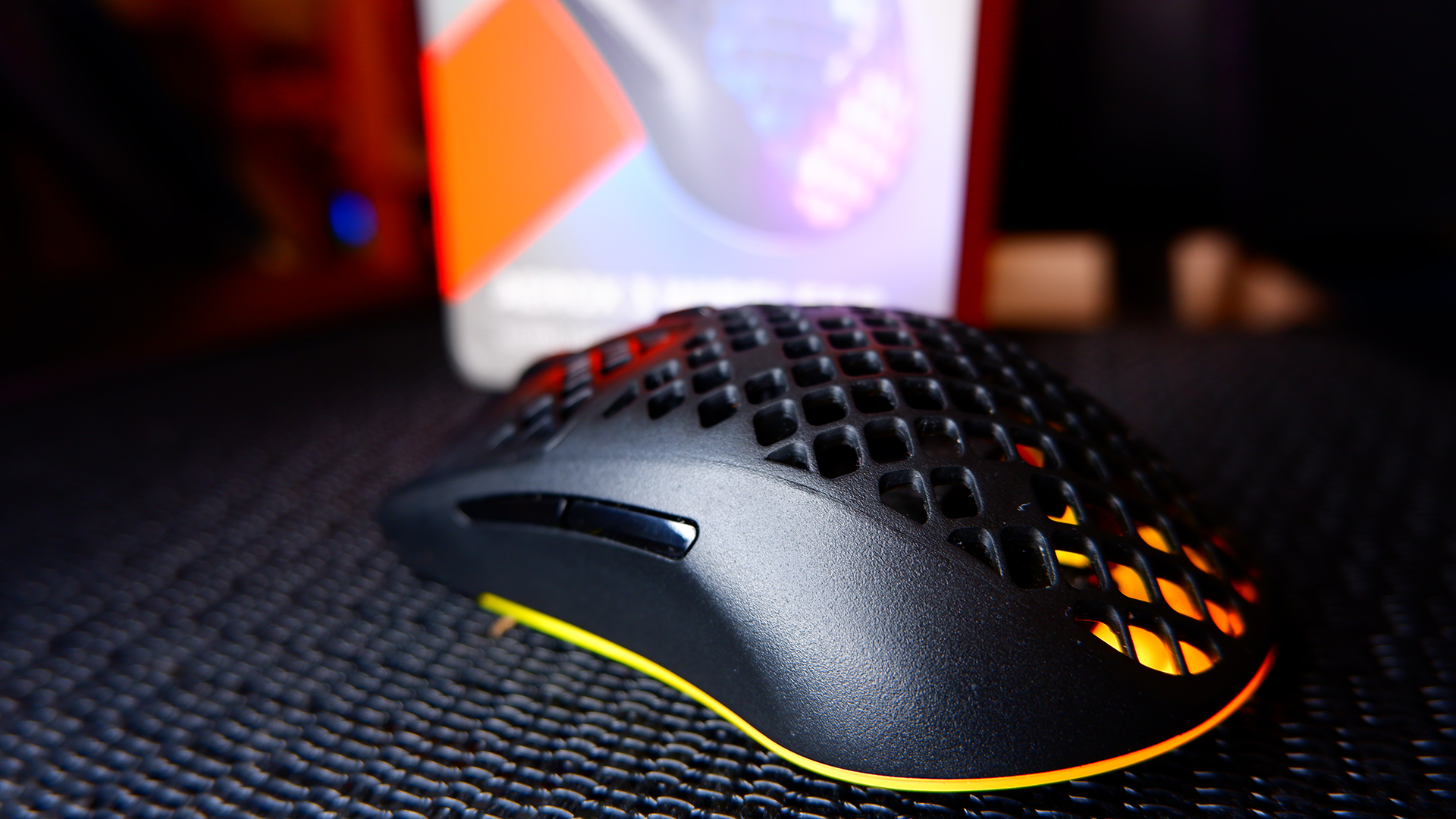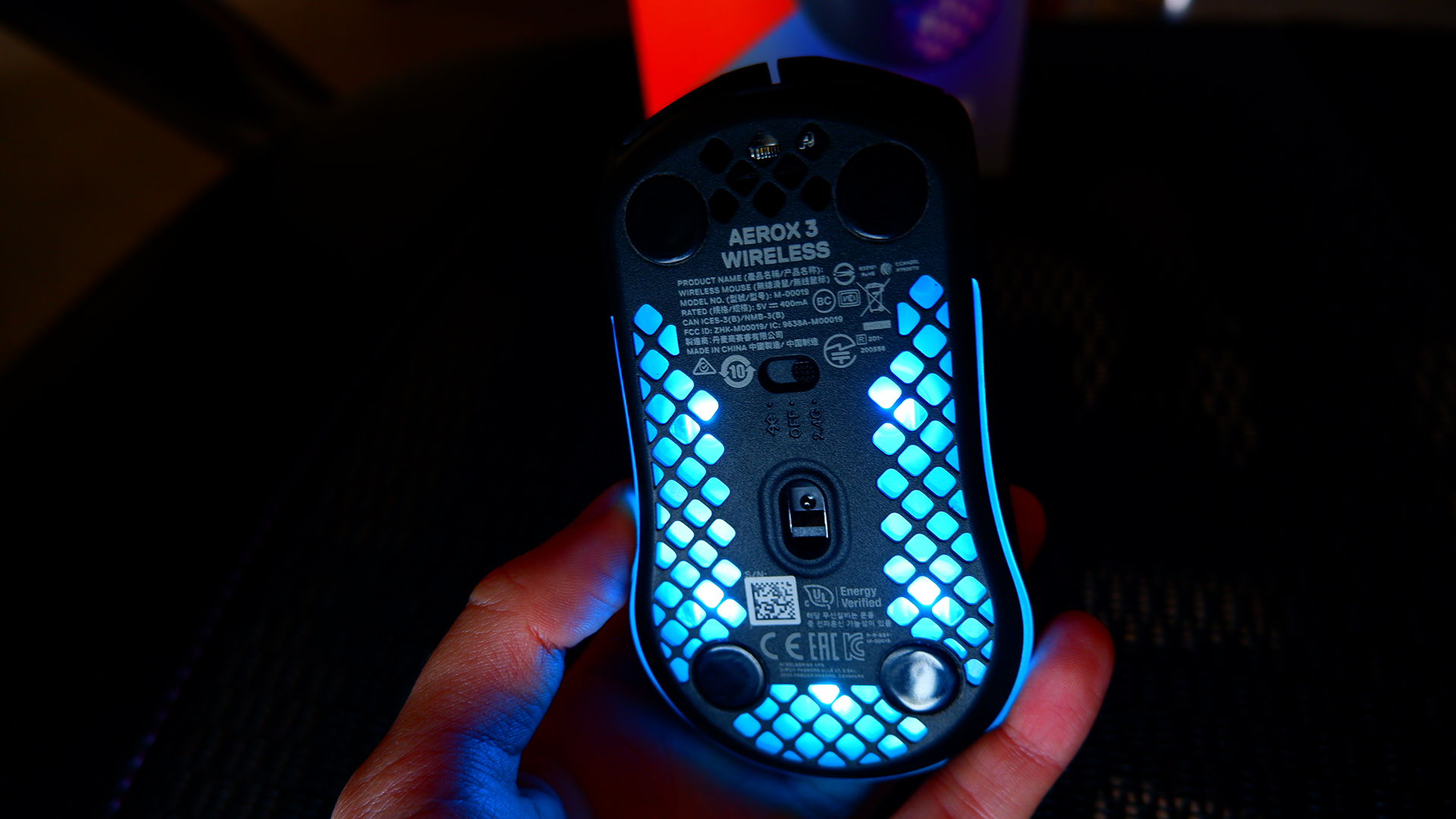Our Verdict
A fully-furnished wireless mouse, the SteelSeries Aerox 3 brings its A-game in every aspect for $100.
For
- Lightweight
- Responsive
- Great size
- Solid wireless connection
Against
- Low-profile scroll wheel
- Slight wake-up lag
PC Gamer's got your back
I've been dual-wielding the SteelSeries Aerox 3 Wireless gaming mouse for a while now, switching back and forth between it and my usual go-to gaming mouse, the Logitech G Pro Wireless, which I've been using daily for the better part of a year. Both are lightweight gaming mice that require no cord, so it seemed only fitting to pit them against one another to see if the Aerox has what it takes to dethrone my favourite rodent.
The Aerox 3 Wireless is off to a great start, too, as you'd be hard-pressed to point to the areas it's lacking due to its weight-saving measures. At just 66g, something had to have been left out... or perhaps not.
The external case has obviously been perforated to shave off weight—18g according to SteelSeries from that singular weight-saving measure alone. It also retains an IP54 rating for dust and water resistance, which is rather impressive.
But beyond that it has all the hallmarks of one of the best gaming mice: convenient thumb buttons, quick DPI switch, comfy shape, accurate sensor, and a sturdy wireless connection. RGB lighting is a plus too, if you're into that.
The wireless connection is provided by either 2.4GHz wireless or Bluetooth, and is powered by SteelSeries' Quantum 2.0 Wireless technology. Everyone has a fancy name for their wireless nubbins nowadays, and we won't rob SteelSeries of its chance to boast that it too has fast and reliable wireless connection tech.
Quantum 2.0 also does deliver with no discernible lagging or dropouts during my time with it. A convenient switch on the underside of the mouse allows you to switch between the 2.4GHz wireless connection and built-in Bluetooth for that little greater flexibility between devices. As per the norm, Bluetooth is notably slower and may cause a little trouble when gaming at speed.

When the Aerox is disconnected from its USB Type-C cable—yes, finally, some Type-C love in gaming mice—it lasts a decent length for daily use without charging interruptions. SteelSeries tout a lengthy 80 hour battery life, sans lighting. In practice I found his mouse to be running out of juice around the two day mark with RGB lighting ablaze.
To help the mouse along there are some proactive battery saving measures on by default, such as Illumination Smart Mode and a speedy sleep function.
Illumination Smart Mode senses when the mouse is in motion and disables the RGB lighting. While RGB lighting appears more arbitrary than ever with this feature enabled, it does at least mean you don't need to worry about the mouse's tri-zone RGB lighting sapping your battery while your attention is planted on-screen.
The sleep function is customisable in the SteelSeries Engine app—anything from 30 seconds to 20 minutes. A great battery saving method, no doubt. My biggest gripe with the Aerox, though, is in waking it back up from sleep. Mouse movement won't suffice, you'll need to click one of the mouse buttons to kick it out of a dream state, and even when you do that process takes a moment to whirr up, which makes for a tangible delay.
Such a delay I'm yet to experience with any other wireless gaming mice, and it can be a little jarring at times. I've settled for a 20 minute sleep timer as a makeshift solution but that's no doubt at the expense of battery life.
SteelSeries offers no percentage for battery, only a level indicator. As such it's a little tricky to tell just how much power is remaining with any accuracy. Still, the included USB Type-C cable is light and sturdy enough that it's not a significant distraction to keep it plugged in while gaming. And that Type-C connector comes as a big plus—I'm slowly but surely reaching the point where Micro-USB cables can be entirely abolished from my desk.
The SteelSeries TrueMove Air sensor does a mighty job in-game, as well. If it didn't just feel consistent enough, though, a run in MouseTester shows a consistent count with little deviation. Not a single erroneous point or extreme outlier by my testing, in fact.

That sensor supports up to 18,000 CPI (SteelSeries gets it, CPI not DPI), and you can change CPI/DPI profiles easily with the button behind the scroll wheel. Pretty standard stuff. Each CPI stage set in the SteelSeries Engine software is represented by a different colour displayed across the RGB LEDs, which will flash up before returning to your custom lighting profile.
Speaking of the Engine software, the level of customisation available with the Aerox 3 is rather something. Boot up the app and head to the mouse-specific settings and you'll be greeted with an extensive array of dials, graphs, customisable actions, and macro settings to tweak to your liking.
Everything from angle snapping to acceleration is within easy reach through the app, and a live preview function means you can give it all a test whirl before overwriting your existing settings.
In that head to head with the Logitech G Pro Wireless then, the Aerox clearly wins on weight at 66g to 80g. It's got the G Pro beat in software, too. Not in looks, the SteelSeries Engine appears a little dated, but all the information you could need is front and centre and there's more of it to tweak to your liking.

It also looks the part of a gamer mouse more so than the G Pro, which could be either a positive or negative depending on your outlook on that aesthetic. Personally, I lean towards the G Pro on this one, if only because the Aerox feels like it's built of slightly cheaper materials, a symptom of many a light gaming mouse, but I could also easily see why it appeals.
In overall design then, it's again one for the G Pro here. But not by much—the Aerox is just a little low-profile for my liking and less supportive to the palm.
The G Pro also has the Aerox beat in left-handed ergonomics. The Aerox isn't quite a write-off for left-handed users, but you'll have to sacrifice the dual thumb buttons, which are otherwise very well placed and easy to use for right-handed folk.
The Aerox 3 can perhaps be forgiven some of its minor missteps for its price. It comes in at $100, a whole $30 cheaper than the G Pro Wireless. That's cheaper than most premium wireless gaming mouse with as many features, even, and you can't really argue with the calibre of mouse for the money. Nor can you the quality of this rodent—the Aerox 3 doesn't feel any less hardy for its weight-saving shell.
We recommend upgrading to a wireless mouse before all other components here at PC Gamer, and the Aerox 3 makes for a great first step to that cable-free setup. It's just not quite savvy enough to kick the G Pro Wireless off my desk every day. But it came pretty close...
A fully-furnished wireless mouse, the SteelSeries Aerox 3 brings its A-game in every aspect for $100.

Jacob earned his first byline writing for his own tech blog. From there, he graduated to professionally breaking things as hardware writer at PCGamesN, and would go on to run the team as hardware editor. He joined PC Gamer's top staff as senior hardware editor before becoming managing editor of the hardware team, and you'll now find him reporting on the latest developments in the technology and gaming industries and testing the newest PC components.


